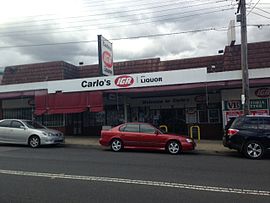Birrong
| Birrong Sydney, New South Wales | |||||||||||||||
|---|---|---|---|---|---|---|---|---|---|---|---|---|---|---|---|
 Auburn Road, Birrong | |||||||||||||||
| Population | 3,103 (2016 census)[1] | ||||||||||||||
| Postcode(s) | 2143 | ||||||||||||||
| Elevation | 40 m (131 ft) | ||||||||||||||
| Location | 22 km (14 mi) south-west of Sydney CBD | ||||||||||||||
| LGA(s) | City of Canterbury-Bankstown | ||||||||||||||
| State electorate(s) | Bankstown | ||||||||||||||
| Federal division(s) | Blaxland | ||||||||||||||
| |||||||||||||||
Birrong, a suburb of local government area City of Canterbury-Bankstown, is located 22 kilometres south-west of the Sydney central business district, in the state of New South Wales, Australia, and is a part of the South-western Sydney region.
Birrong shares its postcode of 2143 with neighbouring suburbs Regents Park and Potts Hill.
Landmarks[edit]
Birrong features a large number of community facilities such as six soccer/rugby league fields, tennis courts, a large natural park reserve, a bowls club, and a swimming pool. Birrong also has two high schools, Birrong Boys High School and Birrong Girls High School, and a primary school. A small group of shops is located on Auburn Road, featuring a barber, bakery, cafes, takeaway restaurants, IGA (including bottle shop and butcher), and hair salon.
History[edit]
The Aboriginal word Birrong, meaning star, was adopted as the suburb's name around 1927.[2]
One of the first settlers of Birrong was Joseph Hyde Potts who was granted land in the area in 1835 and has Potts Hill named after him. Development in the area of Birrong increased with the opening of the railway in 1928. Birrong Park, an area that was subject to flooding, was drained as relief work during the Great Depression (1929–1934). The post office opened in 1955.[3]
Demographics[edit]
In the 2016 census the population of Birrong was 3,103.
The median age of the Birrong population was 35 years, less than the national median of 38.
51.2% of people were born in Australia. The most common countries of birth were Vietnam 16.9%, China 4.4% and Lebanon 4.0%.
32.6% of people only spoke English at home. Other languages spoken at home included Vietnamese 22.1%, Arabic 15.3%, Cantonese 5.1% and Mandarin 5.1%.
The religious make up of Birrong was Catholic 20.8%, Islam 18.1%, Buddhism 16.4% and No Religion 15.7%.[1]
Education[edit]
Birrong Girls High School is a public girls high school that was established as a girls' comprehensive high school in 1957. There are 820 students (2006 estimate) from a wide variety of cultural backgrounds enrolled in the school. 84% of students are from non-English speaking background (NESB) which represents 46 language groups.
Transport[edit]
Birrong is served by a railway station on the Bankstown Line of the Sydney Trains network. Birrong is also serviced by a bus network run by Transit Systems.
References[edit]
- ^ a b Australian Bureau of Statistics (27 June 2017). "Birrong (New South Wales Suburb)". 2016 Census QuickStats. Retrieved 12 April 2018.
- ^ "History Suburb Names". Archived from the original on 8 March 2008. Retrieved 13 February 2008.
- ^ The Book of Sydney Suburbs, Compiled by Frances Pollon, Angus & Robertson Publishers, 1990, Published in Australia ISBN 0-207-14495-8, page 30
33°53′35″S 151°1′23″E / 33.89306°S 151.02306°E

